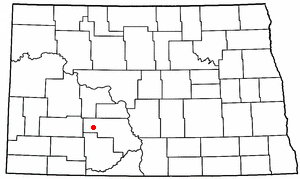Glen Ullin, North Dakota
|
|
Glen Ullin is a city located in Morton County, North Dakota. As of the 2000 census, the city had a total population of 865.
Geography
Glen Ullin is located at 46°48'52" North, 101°49'51" West (46.814336, -101.830716)Template:GR.
According to the United States Census Bureau, the city has a total area of 2.8 km² (1.1 mi²). 2.7 km² (1.0 mi²) of it is land and 0.1 km² (0.04 mi²) of it is water. The total area is 2.80% water.
Demographics
As of the censusTemplate:GR of 2000, there are 865 people, 369 households, and 221 families residing in the city. The population density is 321.1/km² (831.2/mi²). There are 405 housing units at an average density of 150.4/km² (389.2/mi²). The racial makeup of the city is 99.42% White, 0.00% African American, 0.23% Native American, 0.00% Asian, 0.00% Pacific Islander, 0.00% from other races, and 0.35% from two or more races. 0.00% of the population are Hispanic or Latino of any race.
There are 369 households out of which 22.5% have children under the age of 18 living with them, 54.5% are married couples living together, 4.3% have a female householder with no husband present, and 40.1% are non-families. 37.9% of all households are made up of individuals and 23.6% have someone living alone who is 65 years of age or older. The average household size is 2.08 and the average family size is 2.77.
In the city the population is spread out with 17.9% under the age of 18, 4.3% from 18 to 24, 19.2% from 25 to 44, 19.7% from 45 to 64, and 39.0% who are 65 years of age or older. The median age is 52 years. For every 100 females there are 86.0 males. For every 100 females age 18 and over, there are 85.9 males.
The median income for a household in the city is $27,688, and the median income for a family is $32,368. Males have a median income of $24,444 versus $16,513 for females. The per capita income for the city is $16,258. 8.3% of the population and 4.4% of families are below the poverty line. Out of the total population, 10.8% of those under the age of 18 and 12.3% of those 65 and older are living below the poverty line.

